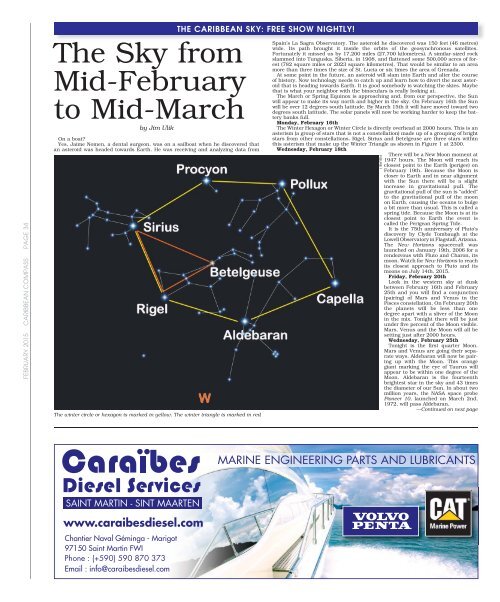Caribbean Compass Yachting Magazine February 2015
Welcome to Caribbean Compass, the most widely-read boating publication in the Caribbean! THE MOST NEWS YOU CAN USE - feature articles on cruising destinations, regattas, environment, events...
Welcome to Caribbean Compass, the most widely-read boating publication in the Caribbean! THE MOST NEWS YOU CAN USE - feature articles on cruising destinations, regattas, environment, events...
You also want an ePaper? Increase the reach of your titles
YUMPU automatically turns print PDFs into web optimized ePapers that Google loves.
THE CARIBBEAN SKY: FREE SHOW NIGHTLY!<br />
FEBRUARY <strong>2015</strong> CARIBBEAN COMPASS PAGE 34<br />
The Sky from<br />
Mid-<strong>February</strong><br />
to Mid-March<br />
by Jim Ulik<br />
On a boat<br />
Yes, Jaime Nomen, a dental surgeon, was on a sailboat when he discovered that<br />
an asteroid was headed towards Earth. He was receiving and analyzing data from<br />
The winter circle or hexagon is marked in yellow. The winter triangle is marked in red<br />
Spain’s La Sagra Observatory. The asteroid he discovered was 150 feet (46 metres)<br />
wide. Its path brought it inside the orbits of the geosynchronous satellites.<br />
Fortunately it missed us by 17,200 miles (27,700 kilometres). A similar-sized rock<br />
slammed into Tunguska, Siberia, in 1908, and flattened some 500,000 acres of forest<br />
(782 square miles or 2023 square kilometres). That would be similar to an area<br />
more than three times the size of St. Lucia or six times the area of Grenada.<br />
At some point in the future, an asteroid will slam into Earth and alter the course<br />
of history. Now technology needs to catch up and learn how to divert the next asteroid<br />
that is heading towards Earth. It is good somebody is watching the skies. Maybe<br />
that is what your neighbor with the binoculars is really looking at.<br />
The March or Spring Equinox is approaching and, from our perspective, the Sun<br />
will appear to make its way north and higher in the sky. On <strong>February</strong> 16th the Sun<br />
will be over 12 degrees south latitude. By March 15th it will have moved toward two<br />
degrees south latitude. The solar panels will now be working harder to keep the battery<br />
banks full.<br />
Monday, <strong>February</strong> 16th<br />
The Winter Hexagon or Winter Circle is directly overhead at 2000 hours. This is an<br />
asterism (a group of stars that is not a constellation) made up of a grouping of bright<br />
stars from other constellations. Rigel, Sirius and Betelgeuse are three stars within<br />
this asterism that make up the Winter Triangle as shown in Figure 1 at 2300.<br />
Wednesday, <strong>February</strong> 18th<br />
There will be a New Moon moment at<br />
1947 hours. The Moon will reach its<br />
closest point to the Earth (perigee) on<br />
<strong>February</strong> 19th. Because the Moon is<br />
closer to Earth and in near alignment<br />
with the Sun there will be a slight<br />
increase in gravitational pull. The<br />
gravitational pull of the sun is “added”<br />
to the gravitational pull of the moon<br />
on Earth, causing the oceans to bulge<br />
a bit more than usual. This is called a<br />
spring tide. Because the Moon is at its<br />
closest point to Earth the event is<br />
called the Perigean Spring Tide.<br />
It is the 75th anniversary of Pluto’s<br />
discovery by Clyde Tombaugh at the<br />
Lowell Observatory in Flagstaff, Arizona.<br />
The New Horizons spacecraft was<br />
launched on January 19th, 2006 for a<br />
rendezvous with Pluto and Charon, its<br />
moon. Watch for New Horizons to reach<br />
its closest approach to Pluto and its<br />
moons on July 14th, <strong>2015</strong>.<br />
Friday, <strong>February</strong> 20th<br />
Look in the western sky at dusk<br />
between <strong>February</strong> 16th and <strong>February</strong><br />
25th and you will find a conjunction<br />
(pairing) of Mars and Venus in the<br />
Pisces constellation. On <strong>February</strong> 20th<br />
the planets will be less than one<br />
degree apart with a sliver of the Moon<br />
in the mix. Tonight there will be just<br />
under five percent of the Moon visible.<br />
Mars, Venus and the Moon will all be<br />
setting just after 2000 hours.<br />
Wednesday, <strong>February</strong> 25th<br />
Tonight is the first quarter Moon.<br />
Mars and Venus are going their separate<br />
ways. Aldebaran will now be pairing<br />
up with the Moon. This orange<br />
giant marking the eye of Taurus will<br />
appear to be within one degree of the<br />
Moon. Aldebaran is the fourteenth<br />
brightest star in the sky and 43 times<br />
the diameter of our Sun. In about two<br />
million years, the NASA space probe<br />
Pioneer 10, launched on March 2nd,<br />
1972, will pass Aldebaran.<br />
—Continued on next page<br />
FIGURE 1<br />
MARINE ENGINEERING PARTS AND LUBRICANTS<br />
SAINT MARTIN - SINT MAARTEN<br />
www.caraibesdiesel.com<br />
Chantier Naval Géminga - Marigot<br />
97150 Saint Martin FWI<br />
Phone : (+590) 590 870 373<br />
Email : info@caraibesdiesel.com


















